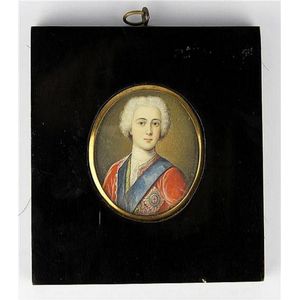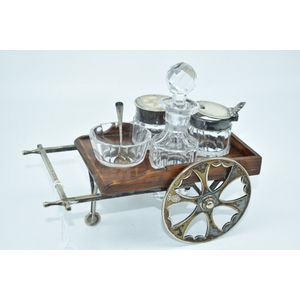Victorian Oak & Crystal Cart Cruet Set with Silver Plate
Victorian English oak and silver plated and crystal cruet set in the form of a cart with diamond registration mark
You must be a subscriber, and be logged in to view price and dealer details.
Subscribe Now to view actual auction price for this item
When you subscribe, you have the option of setting the currency in which to display prices to $Au, $US, $NZ or Stg.
This item has been sold, and the description, image and price are for reference purposes only.
- Victorian Period - The Victorian period of furniture and decorative arts design covers the reign of Queen Victoria from 1837 to 1901. There was not one dominant style of furniture in the Victorian period. Designers used and modified many historical styles such as Gothic, Tudor, Elizabethan, English Rococo, Neoclassical and others, although use of some styles, such as English Rococo and Gothic tended to dominate the furniture manufacture of the period.
The Victorian period was preceded by the Regency and William IV periods, and followed by the Edwardian period, named for Edward VII (1841 ? 1910) who was King of the United Kingdom and the British Dominions and Emperor of India for the brief period from 1901 until his death in 1910. - Oak - Native to Europe and England, oak has been used for joinery, furniture and building since the beginning of the medieval civilisation. It is a pale yellow in colour when freshly cut and darkens with age to a mid brown colour.
Oak as a furniture timber was superceded by walnut in the 17th century, and in the 18th century by mahogany,
Semi-fossilised bog oak is black in colour, and is found in peat bogs where the trees have fallen and been preserved from decay by the bog. It is used for jewellery and small carved trinkets.
Pollard oak is taken from an oak that has been regularly pollarded, that is the upper branches have been removed at the top of the trunk, result that new branches would appear, and over time the top would become ball-like. . When harvested and sawn, the timber displays a continuous surface of knotty circles. The timber was scarce and expensive and was used in more expensive pieces of furniture in the Regency and Victorian periods. - Registered Design - During the period 1842-1883 the Patent Office issued a diamond mark along with the registration number when a design was registered.
Besides indicating that the design had been registered, a diamond mark offered the buyer the reassurance of knowing an item was of British design. It assured the person registering the design a degree of protection from copying.
The mark was created to identify the type of material used (known as the class), how many items were included, (sometimes known as bundles or packages), and the date of registration.
On the diamond mark the year of registration is shown along with the month code. However, there are two ranges of year codes; 1842-1867 and 1868-1883. By looking at the design of the diamond mark you should be able to determine the correct year from the design of the diamond mark and the placing of the day number.
Source and further information: http://www.nationalarchives.gov.uk/records/research-guides/reg-design-diamond.htm
This item has been included into following indexes:
Visually similar items

Royal Worcester hand painted cabinet plate 1880's
Sold by
in
for
You can display prices in $Au, $US, $NZ or Stg.

Gordon Andrews. Pair of circular stools. Fibreglass & steel
Sold by
in
for
You can display prices in $Au, $US, $NZ or Stg.

Miniature portrait of a late 18th century nobleman set in a timber frame. Condition good, minor wear. Length 14.3 cm
Sold by
in
for
You can display prices in $Au, $US, $NZ or Stg.

Kangaroo cast metal bookends, approx 19 cm high (2)
Sold by
in
for
You can display prices in $Au, $US, $NZ or Stg.
